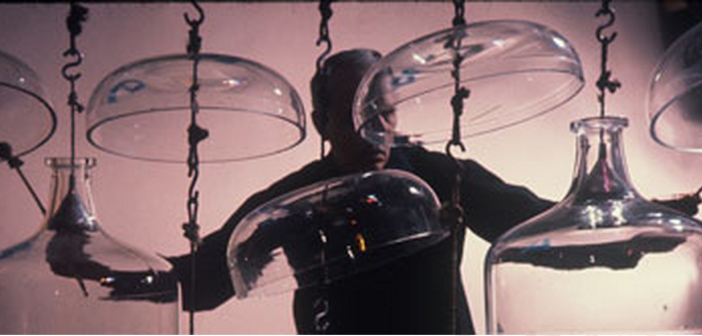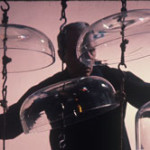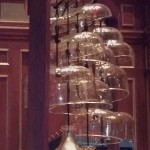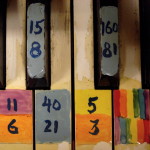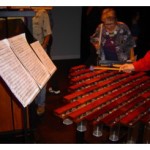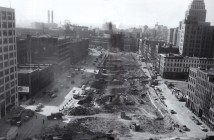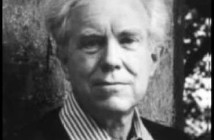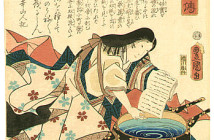And I quote.
I quote Dean Drummond from the September 19 workshop at New England Conservatory entitled Partch's Tuning: Beyond 43.
Harry Partch was a composer and inventor best remembered for the creation of a 43-tone-per-octave scale and an array of microtonal instruments capable of playing music composed using his scale. How do 'not a purist' and a fascination so persistent that it leads one to develop a 43-tone-per-octave scale and create their own instruments fit together?
There is a word that consistently emerges throughout the workshop conducted by Dean Drummond, a composer/inventor and Partch's former assistant, that may offer a clue: corporeal. Drummond comments on the unique identity of each instrument. In fact, each instrument’s uniqueness is manifold. Firstly, each is one of a kind, inviting comparisons to sculpture. The configuration and number of tones for each instrument is unique: some instruments utilize all 43-tones of Partch's scale and others only a subset; they have tight rows of strings (Harmonic Canons), a diamond configuration of sounding panels (Diamond Marimba), or shyly hide inside an almost ordinary-looking pedal organ (Chromelodeon). Each is unique in its relationship to the body of the performer: their sizes range from hand-held to almost comically large and feature many degrees of intricacy. In a certain way, these instruments function like people-- I'm not trying to endow them with spiritual being, but seriously-- on a functional level. Each has a history or a creation story. They set up an inviting otherness.
The beautiful and crowd-pleasing Cloud Chamber Bowls convey nothing of the anarchy of their creation. They are made from Pyrex carboys. Pyrex is notoriously difficult to cut or alter. However, it is robust enough to stand up to use as a percussive instrument and has an intriguing timbre. Partch developed a method of scoring a Pyrex carboy where he wished to divide it, wrapping the scored area with bare electrical wire, sending current through the wire until it was piping hot, quickly removing the wire, and immediately dropping the carboy into vat of cold water causing it to crack along the designated line. Drummond commented on his, understandable, uneasiness with this bustling combination of electricity and water.
Then he said something I found even more fascinating. If a Cloud Chamber Bowl broke and was replaced, the musical part scored for that instrument was re-written. If a Cloud Chamber Bowl breaks, it is virtually impossible to produce an exact duplicate, leading one to reconsider how the instrument can best be utilized. This is completely contrary to Western practice in which the score serves as a blueprint and instruments as objects which obey it. Historically, instruments sometimes have to be invented in order to realize a composer's vision: for example, the Wagner Tuba for the Ring Cycle. So too, for the microtonal polyphony of Partch's imaginings. But what interests me here is that the relationship is bi-directional. A composer creates an instrument in order to realize their compositional vision, but here the instrument turns the process backwards and begins to structure the composition itself. We see this process, the ever-changing relationship between intention and technology (in a broad sense of the word), at work in a concentrated way in Partch's music.
For me, this also triggers reflection on current artistic movements incorporating circuit-bending, home-brew electronics, and repurposed analog equipment. The comparison can be grounded in additional ways. Partch's instruments-- however studied or revered-- retain the mark of their author's, sometimes heavy, hand. There is a charming patina in the fraying bungee chords, visible screws, and hand-painted ratios. A taxidermy animal claw adorns a mallet for the Spoils of War (made with brass artillery casings). The point of these instruments was not to be reproduced in mass quantities; that would be entirely beside the point. Or perhaps even a true impossibility. I'll venture to say that the point was invention; continual invention, reflection, and re-invention. Conversely, the music can not be reduced to a purely formal set of relationships however fascinating the use of the 21st and 33rd harmonics or undertonalities may be. Drummond was asked how he thought Partch would feel about the idea of re-scoring his music for other instruments: "I think he'd be horrified".
How does this play out in an actual performance? On to Thursday, September 20th and the concert Harry Partch: Images and Intrusions. On the program we have Before the Last Laugh and Congressional Record composed by Dean Drummond and Yonah's Dream by Matthew Rosenblum before intermission and O Frabjous Day! (The Jabberwock) and Eleven Intrusions both composed by Partch in the second half.
There is a distinction that I have frequently drawn for myself when creating or critiquing sonic art: does it transport or transform? Does the piece I am listening to function by transporting me as a listener to another (imaginary) space? This can be incredibly rewarding-- allowing me to enter arctic ice caves, overhear a sandstorm on Jupiter, or crawl into the belly of a piano. Or does the piece I am listening to attempt to transform either myself or its own sonic materials?
This is where I find myself drawing the line between the first half of the concert featuring works composed by Drummond and Rosenblum, and the second, featuring the music of Harry Partch himself. Although Rosenblum and especially Drummond wrote clever, novel pieces that were clearly virtuosic in their understanding of the instruments and microtonal composition-- they retained the character of pieces that transport. I would isolate this in large part to their heavy use of instruments such as the flute and synthesizer. These never quite managed to appear natural beside Partch's instrumental ensemble. Meanwhile, Partch's compositions are pieces which transform. The crowning glory of the concert is Partch's Eleven Intrusions-- and in particular Cloud Chamber Music. The ghostly, gongly sound of the Cloud Chamber Bowls combines with uncanny pitch bends and glissandi-- then in burst reedy percussive rhythms and the voices of performers intoning a Zuni Native-American song grounded by the enormous enveloping warmth of the Bass Marimba. If you could crawl inside the world of a warped wax record from an ethnographer's encounter with a long lost tribe it might sound just like this-- melted, but distinctly North American. The seamless blending of the intoning voices in Cloud Chamber Music and the intoning Baritone narrator throughout Eleven Intrusions with Partch's instrumental ensemble evidences that these instruments were lived with and known in all their particularities. It often sounds as though the voice is conjuring the instruments themselves.
What is the method of transformation? Some of it is undoubtedly formal; true. Some of it is technique; all the performers are to be commended for their virtuosic and energetic performances. But here there is a level of theatricality built in-- the player climbs atop the Bass Marimba as though he might a shrine from one of Jodorowsky's films. The players adapt uncanny postures and focus their attention in ways that vary--sometimes ever so slightly, sometimes greatly-- from any other kind of musical performance I have ever seen. The two players of the Zoomoozophone (Drummond's invention) are like gracefully conjoined twins-- completing each other's sonic gestures as they dance their mallets up and down the pieces of what partially resembles an enormous bent panpipe. Hands slide up Adapted Guitar necks and plectrums feel their way across 44-string Harmonic Cannons. The Cloud Chamber Bowls echo in the background-- half gong, half giant wine glass. It's an example of performance that is always already theatre for the non-initiate.
- Partch’s Cloud Chamber Bowls
- Cloud Chamber Bowls at NEC
- Detail of Partch’s Chromalodeon from the Harry Partch Institute, photo by Seth Tisue
- Boo II, photo by Newband
- Diamond Marimba
All images are courtesy of Amber Vistein and New England Conservatory.

